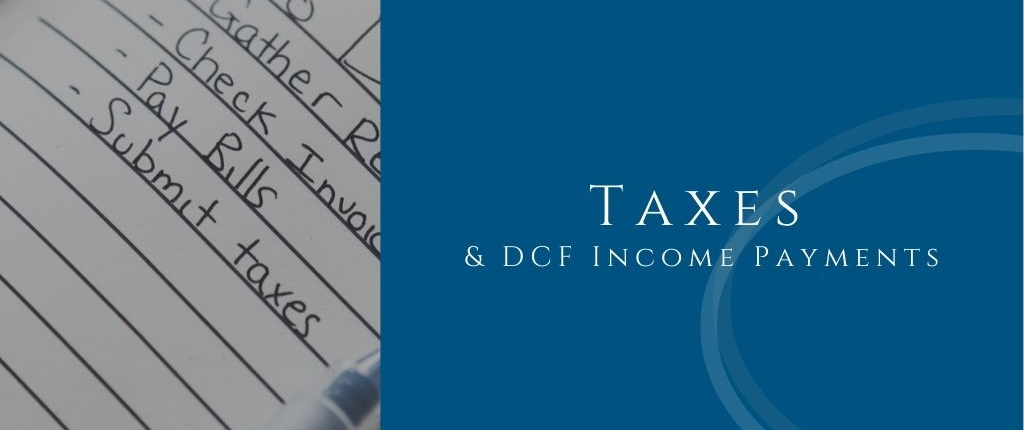
How much tax will you owe on your Secondary Market Annuity? Structured settlements are tax-free awards to the original annuitant, per U.S. Code § 130, and carriers, therefore, do not issue IRS form 1099-INT for the payments to the original payees.
U.S. Code § 5891 and IRS audit guidelines outline how a new assignee obtains an existing payment stream by means of qualified order in compliance with § IRS Section 5891. This is the path followed by DCF Exchange on all transfers of structured settlement payments and is documented in the closing book. These assigned payments are what we call Secondary Market Annuities.
In an IRS § 5891 compliant transfer, the tax-free treatment of income is preserved for the original annuitant, and the parties do not face a risk of an excise penalty tax. But just because the payments are tax-free to the original annuitant and no 1099-INT is issued, this does not mean it’s tax-free to the purchaser of an assigned payment stream.
As with any type of income, the tax treatment of income from assigned structured settlement payments is ultimately determined by the taxpayer and their tax adviser. Income from assigned payment streams is typically considered ordinary income and is recognized when received.
How To Calculate Taxable Income on Secondary Market Annuities
While the sale proceeds are not taxable for the original payee, the portion of a Secondary Market Annuity that is income (vs principal) is subject to tax for the purchaser. Carriers do not issue IRS Forms 1099 to the purchaser, but the taxable income portion of each payment is the taxpayer’s responsibility.
Income from assigned payment streams are typically considered ordinary income and recognized for tax purposes only when it is received, leaving unrealized income to defer, accrue, and compound.
The portion of a payment that is reportable as income (and not principal) is ultimately determined by the taxpayer. However, DCF Exchange obtained guidance confirming favorable deferral treatment of Secondary Market Annuities from a well-recognized nationwide accounting firm, which we make available to our clients. This guidance states that the income portion of a payment is (1) the amount received minus (2) the price of purchase for that payment. That allows for substantial deferral as early payments have proportionally less taxable income, and later payments have more.
DCF Exchange performs the calculations following this reporting method and displays the taxable portion of each Secondary Market Annuity on the Payments Schedule.
Please note, if the payment is in an IRA, then all IRA distributions will be taxed when they are taken, not when payments are received into your IRA.
Using The Exclusion Ratio
Some purchasers choose to compute taxes based on an “exclusion ratio” applied to the whole payment stream so as to obtain a consistent ratio of income vs. principal across all payments. For purchasers who use this less favorable tax deferral method, DCF computes the exclusion ratio on the Payments Schedule. While DCF has not obtained tax advice regarding this method, we understand that many purchasers of structured settlement payments use this method of tax reporting
The exclusion ratio works like this: say you paid $100,000 and will receive $200,000 over 100 payments of $2,000 each. Exactly 50% of each payment would be income, and 50% is return of principal. Consult your adviser, but generally, this income is “ordinary income” for IRS purposes.
The exclusion ratio, therefore, is 50%- 1/2 of each payment is taxable income. This article explains it well, but consult your tax adviser for specific questions.
Summary of Taxes & Secondary Market Annuities
So even though you will not be receiving a 1099 for the payments from the carriers based on current tax law, what happens in the future to tax law is anyone’s guess.
SecondaryAnnuities.com and DCF Exchange, LLC do not offer tax advice, and this page is for general information only, so please be sure to consult your own tax adviser for more info.
Reach out to us if you’d like to:
- Schedule a 1-on-1 video call to discuss your specific needs and situation
- Ask questions about products, carriers, or Secondary Market Annuities in general
- Discuss how Secondary Market Annuities may (or may not) fit into your portfolio

Nathaniel M. Pulsifer, President, DCF Exchange and SecondaryAnnuities.com
(800) 246-1932 | [email protected] | Linkedin




